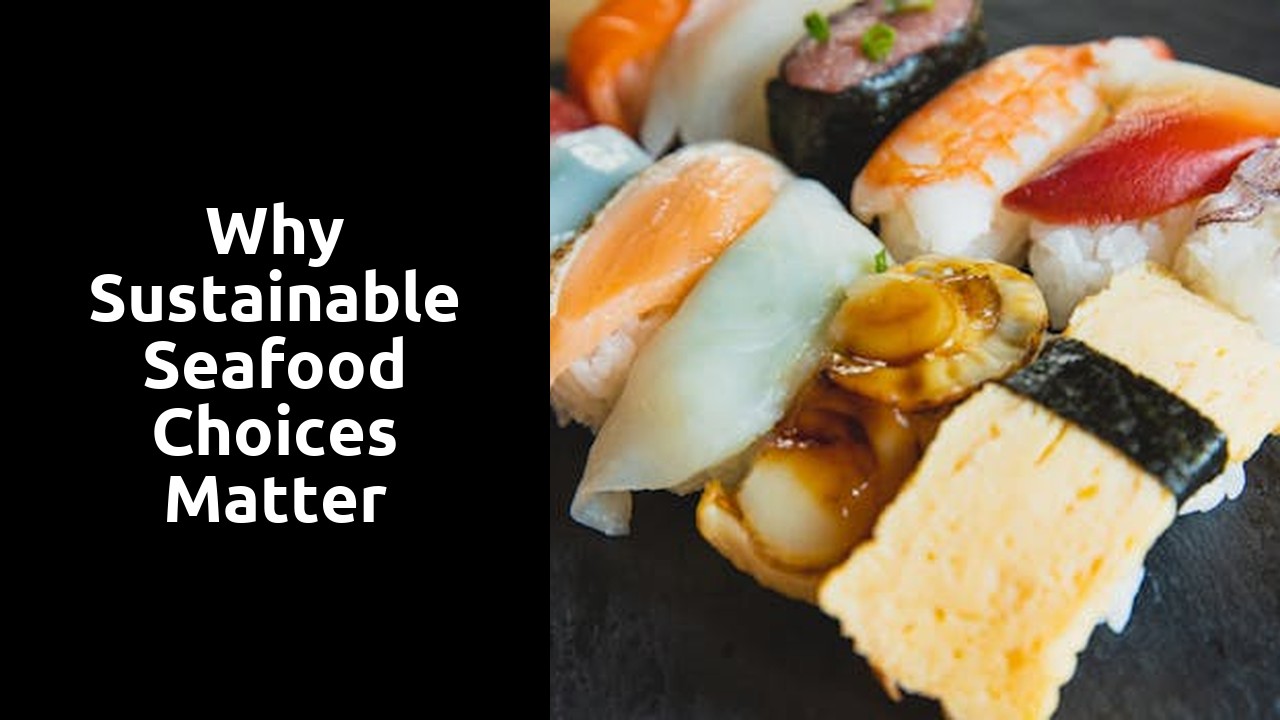Why Sustainable Seafood Choices Matter

Ways to Support Sustainable Fishing Practices
Supporting sustainable fishing practices is crucial for the health of our oceans and the future of seafood. One way to do this is by choosing to buy seafood that has been certified by reputable organisations like the Marine Stewardship Council (MSC) or the Aquaculture Stewardship Council (ASC). These certifications indicate that the seafood has been sourced responsibly, ensuring the long-term sustainability of fish stocks and minimising environmental impact.
Another effective way to support sustainable fishing is by being mindful of the seafood choices we make. Opting for locally caught fish or seafood that is in season can help reduce the carbon footprint associated with transportation and storage. Additionally, educating ourselves about which species are overfished and understanding the importance of sustainable fishing practices can empower us to make informed decisions when selecting seafood products. By making conscious choices and supporting sustainable fishing practices, we can play a significant role in preserving our oceans for generations to come.
Advocating for Policy Changes
Advocating for policy changes is crucial in promoting sustainable seafood choices. By advocating for stricter regulations on fishing practices and more sustainable aquaculture methods, we can help protect marine ecosystems and ensure the future availability of seafood. Policies that limit overfishing, protect endangered species, and promote responsible fishing techniques are essential in preserving our oceans for generations to come.
Furthermore, lobbying for improved transparency in seafood supply chains and labelling can empower consumers to make informed choices when purchasing seafood products. Clear and accurate labelling can help consumers identify sustainable options and avoid supporting unsustainable fishing practices. Advocating for policies that promote traceability and accountability in the seafood industry is essential in driving positive change towards a more sustainable future.
The Role of Aquaculture in Sustainable Seafood Production
Aquaculture, also known as fish farming, plays a crucial role in sustainable seafood production. By cultivating fish in controlled environments, aquaculture helps reduce the pressure on wild fish stocks and lessens the impact of overfishing. Sustainable fish farming methods include responsible feed sourcing, regular monitoring of water quality, and minimising the use of antibiotics and chemicals to ensure the health of the fish and the surrounding ecosystem.
When done correctly, aquaculture can provide a reliable source of seafood without harming the environment. Companies that prioritise sustainable practices in aquaculture contribute to conservation efforts and help meet the growing global demand for seafood. Consumers can support sustainable aquaculture by choosing seafood products certified by reputable organisations, such as the Aquaculture Stewardship Council (ASC) or the Marine Stewardship Council (MSC), which ensure that fish are farmed responsibly and ethically.
Sustainable Fish Farming Methods
Fish farming, also known as aquaculture, plays a vital role in meeting the increasing global demand for seafood. Sustainable fish farming methods have become increasingly important to ensure the long-term health of both aquatic ecosystems and the fish populations being cultivated. Such methods focus on minimising environmental impact, promoting animal welfare, and maintaining the nutritional quality of the seafood produced.
Key sustainable fish farming practices include using natural feeds, limiting antibiotic use, and monitoring water quality to ensure optimal conditions for fish growth. Additionally, integrating aquaculture with other agricultural practices, such as using fish waste as fertiliser for crops, can create a more circular and environmentally friendly system. By prioritising sustainable fish farming methods, we can not only safeguard marine biodiversity but also ensure a stable and secure seafood supply for future generations.
Seafood Consumption Trends and Environmental Impact
Seafood consumption trends have shown a significant increase in recent years, driven by a growing demand for diverse aquatic delicacies. However, this surge in consumption has come at a cost to our marine ecosystems. Overfishing and unsustainable harvesting practices have resulted in declining fish populations and damaged marine habitats worldwide. As consumer preferences continue to shape the seafood industry, it is crucial to raise awareness about the importance of making sustainable choices to protect our oceans for future generations.
The environmental impact of unsustainable seafood consumption extends beyond depleted stocks and fragile ecosystems. Bycatch, the unintentional capture of non-target species, is a prevalent issue in many fishing operations. This indiscriminate practice not only threatens the survival of various marine species but also disrupts the delicate balance of marine food chains. Additionally, the carbon footprint of seafood production, transportation, and distribution contributes to greenhouse gas emissions and climate change. To mitigate these environmental challenges, a collective effort is needed to promote sustainable fishing practices and support initiatives that prioritise the long-term health of our oceans.
Balancing Supply and Demand
Finding a delicate balance between supply and demand is crucial in ensuring sustainable seafood consumption. As the global population continues to rise, the demand for seafood also increases. This growth in demand puts significant pressure on fish stocks and the marine ecosystem, leading to overfishing and environmental degradation. To maintain a sustainable supply of seafood, it is essential to implement responsible fishing practices, regulate fishing quotas, and promote conservation efforts to protect marine habitats.
On the consumer side, understanding the concept of balance between supply and demand is equally important. By making informed choices and supporting sustainable seafood options, individuals can contribute to reducing the pressure on fish populations. This can be achieved by opting for fish species that are abundant and well-managed, choosing seafood products with eco-friendly certifications, and educating oneself about the origins of the seafood being consumed. Through collective efforts to balance supply and demand, we can work towards a more sustainable future for the world's oceans and seafood resources.
Related Links
Why We Need to Address Overfishing of Wild Salmon StocksWhat Are the Environmental Impacts of Wild Salmon Fishing
The Ultimate Guide to Sustainable Seafood
Review: The Best Sustainable Salmon Brands
5 Sustainable Seafood Labeling Certifications to Know
The History of Sustainable Salmon Fishing